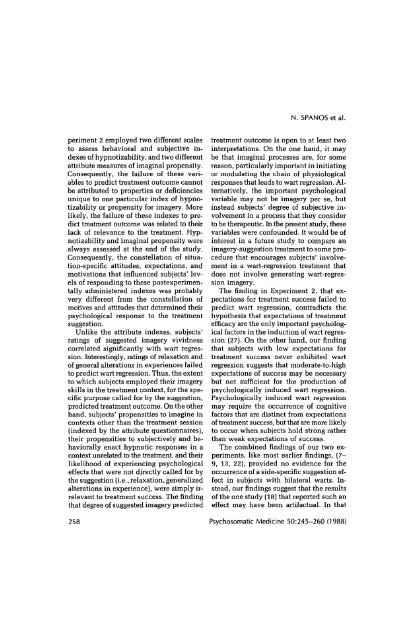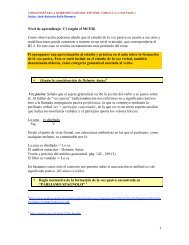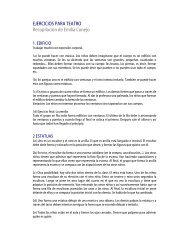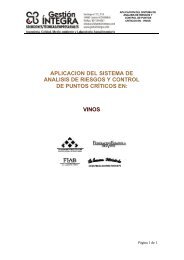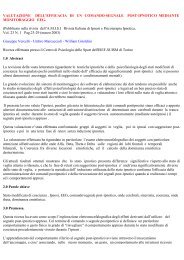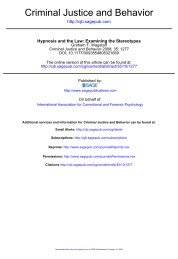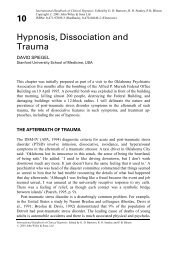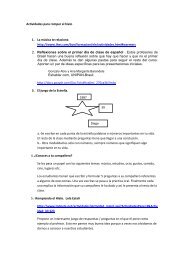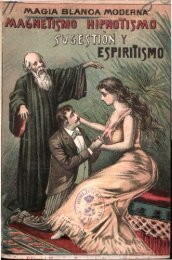Hypnosis, Placebo, and Suggestion in the Treatment of Warts
Hypnosis, Placebo, and Suggestion in the Treatment of Warts
Hypnosis, Placebo, and Suggestion in the Treatment of Warts
Create successful ePaper yourself
Turn your PDF publications into a flip-book with our unique Google optimized e-Paper software.
N. SPANOS et al.periment 2 employed two different scalesto assess behavioral <strong>and</strong> subjective <strong>in</strong>dexes<strong>of</strong> hypnotizability, <strong>and</strong> two differentattribute measures <strong>of</strong> imag<strong>in</strong>al propensity.Consequently, <strong>the</strong> failure <strong>of</strong> <strong>the</strong>se variablesto predict treatment outcome cannotbe attributed to properties or deficienciesunique to one particular <strong>in</strong>dex <strong>of</strong> hypnotizabilityor propensity for imagery. Morelikely, <strong>the</strong> failure <strong>of</strong> <strong>the</strong>se <strong>in</strong>dexes to predicttreatment outcome was related to <strong>the</strong>irlack <strong>of</strong> relevance to <strong>the</strong> treatment. Hypnotizability<strong>and</strong> imag<strong>in</strong>al propensity werealways assessed at <strong>the</strong> end <strong>of</strong> <strong>the</strong> study.Consequently, <strong>the</strong> constellation <strong>of</strong> situation-specificattitudes, expectations, <strong>and</strong>motivations that <strong>in</strong>fluenced subjects' levels<strong>of</strong> respond<strong>in</strong>g to <strong>the</strong>se postexperimentallyadm<strong>in</strong>istered <strong>in</strong>dexes was probablyvery different from <strong>the</strong> constellation <strong>of</strong>motives <strong>and</strong> attitudes that determ<strong>in</strong>ed <strong>the</strong>irpsychological response to <strong>the</strong> treatmentsuggestion.Unlike <strong>the</strong> attribute <strong>in</strong>dexes, subjects'rat<strong>in</strong>gs <strong>of</strong> suggested imagery vividnesscorrelated significantly with wart regression.Interest<strong>in</strong>gly, rat<strong>in</strong>gs <strong>of</strong> relaxation <strong>and</strong><strong>of</strong> general alterations <strong>in</strong> experiences failedto predict wart regression. Thus, <strong>the</strong> extentto which subjects employed <strong>the</strong>ir imageryskills <strong>in</strong> <strong>the</strong> treatment context, for <strong>the</strong> specificpurpose called for by <strong>the</strong> suggestion,predicted treatment outcome. On <strong>the</strong> o<strong>the</strong>rh<strong>and</strong>, subjects' propensities to imag<strong>in</strong>e <strong>in</strong>contexts o<strong>the</strong>r than <strong>the</strong> treatment session(<strong>in</strong>dexed by <strong>the</strong> attribute questionnaires),<strong>the</strong>ir propensities to subjectively <strong>and</strong> behaviorallyenact hypnotic responses <strong>in</strong> acontext unrelated to <strong>the</strong> treatment, <strong>and</strong> <strong>the</strong>irlikelihood <strong>of</strong> experienc<strong>in</strong>g psychologicaleffects that were not directly called for by<strong>the</strong> suggestion (i.e., relaxation, generalizedalterations <strong>in</strong> experience), were simply irrelevantto treatment success. The f<strong>in</strong>d<strong>in</strong>gthat degree <strong>of</strong> suggested imagery predictedtreatment outcome is open to at least two<strong>in</strong>terpretations. On <strong>the</strong> one h<strong>and</strong>, it maybe that imag<strong>in</strong>al processes are, for somereason, particularly important <strong>in</strong> <strong>in</strong>itiat<strong>in</strong>gor modulat<strong>in</strong>g <strong>the</strong> cha<strong>in</strong> <strong>of</strong> physiologicalresponses that leads to wart regression. Alternatively,<strong>the</strong> important psychologicalvariable may not be imagery per se, but<strong>in</strong>stead subjects' degree <strong>of</strong> subjective <strong>in</strong>volvement<strong>in</strong> a process that <strong>the</strong>y considerto be <strong>the</strong>rapeutic. In <strong>the</strong> present study, <strong>the</strong>sevariables were confounded. It would be <strong>of</strong><strong>in</strong>terest <strong>in</strong> a future study to compare animagery-suggestion treatment to some procedurethat encourages subjects' <strong>in</strong>volvement<strong>in</strong> a wart-regression treatment thatdoes not <strong>in</strong>volve generat<strong>in</strong>g wart-regressionimagery.The f<strong>in</strong>d<strong>in</strong>g <strong>in</strong> Experiment 2, that expectationsfor treatment success failed topredict wart regression, contradicts <strong>the</strong>hypo<strong>the</strong>sis that expectations <strong>of</strong> treatmentefficacy are <strong>the</strong> only important psychologicalfactors <strong>in</strong> <strong>the</strong> <strong>in</strong>duction <strong>of</strong> wart regression(27). On <strong>the</strong> o<strong>the</strong>r h<strong>and</strong>, our f<strong>in</strong>d<strong>in</strong>gthat subjects with low expectations fortreatment success never exhibited wartregression suggests that moderate-to-highexpectations <strong>of</strong> success may be necessarybut not sufficient for <strong>the</strong> production <strong>of</strong>psychologically <strong>in</strong>duced wart regression.Psychologically <strong>in</strong>duced wart regressionmay require <strong>the</strong> occurrence <strong>of</strong> cognitivefactors that are dist<strong>in</strong>ct from expectations<strong>of</strong> treatment success, but that are more likelyto occur when subjects hold strong ra<strong>the</strong>rthan weak expectations <strong>of</strong> success.The comb<strong>in</strong>ed f<strong>in</strong>d<strong>in</strong>gs <strong>of</strong> our two experiments,like most earlier f<strong>in</strong>d<strong>in</strong>gs, (7-9, 13, 22), provided no evidence for <strong>the</strong>occurrence <strong>of</strong> a side-specific suggestion effect<strong>in</strong> subjects with bilateral warts. Instead,our f<strong>in</strong>d<strong>in</strong>gs suggest that <strong>the</strong> results<strong>of</strong> <strong>the</strong> one study (18) that reported such aneffect may have been artifactual. In that258 Psychosomatic Medic<strong>in</strong>e 50:245-260 (1988)


